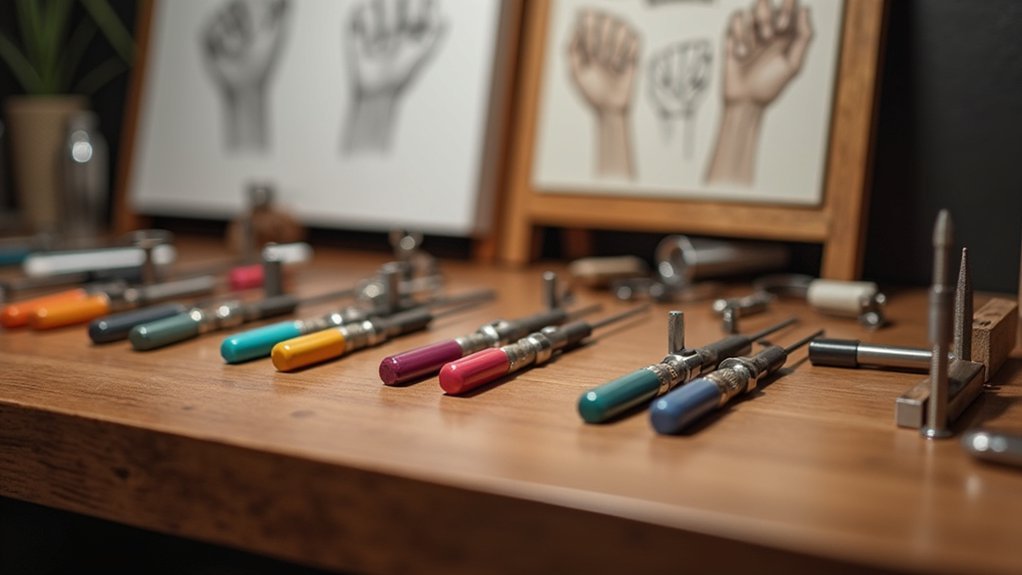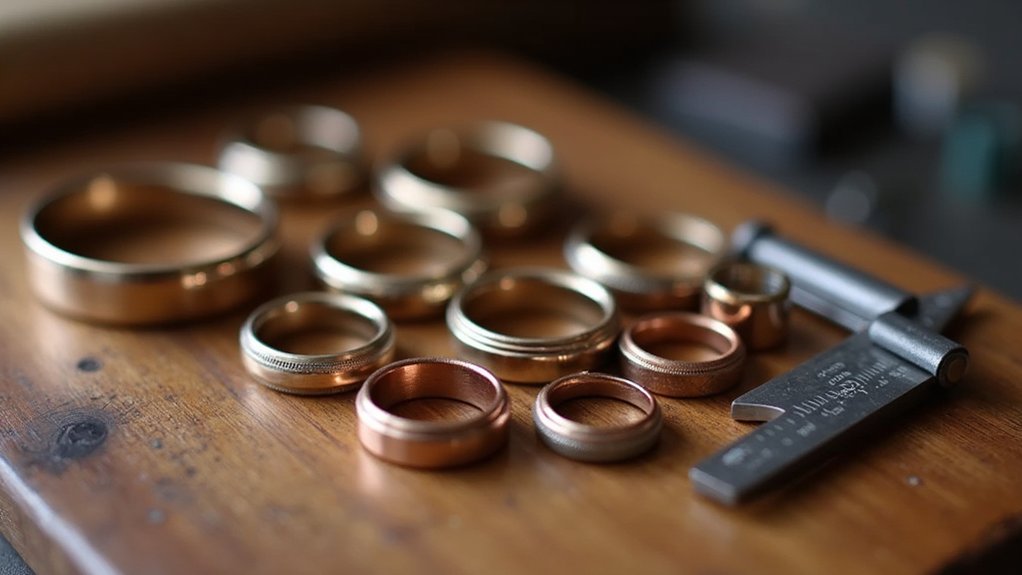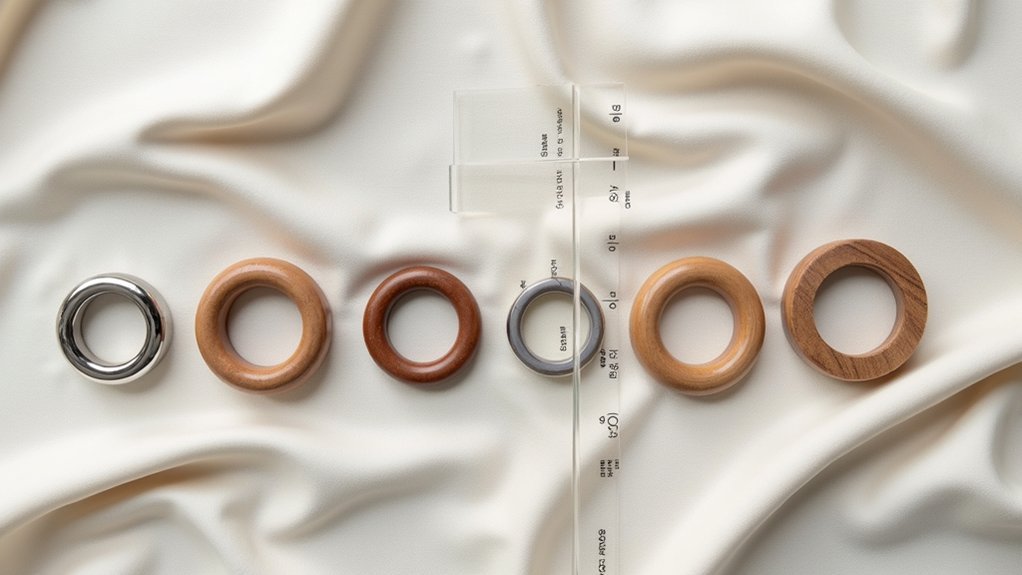You’ve probably experienced that sinking feeling when a client’s custom ring doesn’t fit perfectly despite following standard sizing protocols. Traditional methods often fall short because they don’t account for individual lifestyle factors, hand anatomy variations, or seasonal changes that affect finger size. The difference between a good designer and an exceptional one lies in mastering personalized sizing techniques that anticipate these challenges before they become costly problems.
Understanding Client Lifestyle and Hand Movement Patterns

When sizing rings for clients, you must first analyze their daily routines and physical demands to guarantee ideal fit and comfort.
Client lifestyle directly impacts finger size fluctuations throughout the day. If your client types frequently or performs manual labor, their hand movement patterns will cause fingers to swell and contract regularly, requiring careful consideration during sizing.
You’ll need to account for seasonal changes that affect finger size, particularly during warmer months when swelling occurs.
Active professionals need more secure ring fit to prevent loss during movement. Personal preferences matter too—some clients prefer snug fits while others want looser styles.
Understanding these factors helps you determine appropriate ring design elements, including width adjustments that accommodate active lifestyles and varying comfort levels.
Implementing Multi-Stage Measurement Protocols Throughout the Design Process
You’ll achieve superior ring fit accuracy by establishing measurement checkpoints at three critical stages of your design process.
Start with detailed initial measurements during the design phase, then conduct prototype fittings to catch any sizing adjustments needed before final production.
Complete your protocol with thorough final verification standards that confirm perfect fit before delivery to your client.
Initial Design Phase Measurements
Three fundamental measurements form the backbone of any successful custom ring design: the initial baseline sizing, environmental variation checks, and comfort validation assessments.
During initial design phase measurements, you’ll establish your client’s foundational ring size using professional ring sizers and mandrels. This thorough sizing profile captures critical data beyond simple circumference, including knuckle clearance and finger tapering.
You’ll measure ring size multiple times throughout the day, accounting for natural fluctuations. Your attention to detail during this phase determines whether the final custom engagement ring achieves that perfect fit clients expect.
Document each measurement meticulously, creating a sizing blueprint that’ll guide your entire design process and guarantee dimensional accuracy from concept to completion.
Prototype Fitting Adjustments
After establishing your initial measurements, prototype fitting adjustments become the critical bridge between concept and final creation. When you measure your ring size initially, prototype fittings reveal how your design translates into reality. You’ll discover unique anatomical features that require specific adjustments during these sessions.
| Adjustment Type | Timeline | Purpose |
|---|---|---|
| Comfort Modifications | Week 2-3 | Address pressure points |
| Seasonal Factors | Quarterly | Account for size fluctuations |
| Design Refinements | Week 4-5 | Perfect aesthetic elements |
Digital scanning provides precise measurements, but prototype sessions uncover nuanced comfort preferences. You’ll want to schedule multiple fittings across different seasons, as temperature affects finger size. These adjustments prevent costly post-production resizing while ensuring client satisfaction. Each fitting session builds toward your final creation.
Final Verification Standards
Before crafting your final piece, implementing thorough verification standards guarantees each measurement translates into a perfectly fitted ring.
You’ll want to conduct one last extensive check using calibrated ring sizers to confirm your documented measurements remain accurate. Cross-reference your prototype fitting notes with current ring sizes, accounting for any external factors like temperature changes or swelling that might’ve occurred since your last session.
Test the final ring against your mandrels to ensure proper dimensions before completing the piece. This verification process prevents costly ring resizing issues later.
When you measure a ring one final time, you’re validating that your ideal ring matches the client’s exact specifications. Document these final measurements to complete your multi-stage protocol successfully.
Accommodating Seasonal Finger Size Fluctuations in Custom Designs
While most designers focus on achieving the perfect fit during initial sizing, seasonal temperature variations can transform that ideal ring into either an uncomfortably tight band or a loose piece that risks slipping off.
Summer heat causes finger swelling, making rings feel tighter, while winter cold shrinks finger sizes, creating loose fits.
Fingers expand in heat and contract in cold, causing rings to shift from snug to loose with seasonal temperature changes.
You’ll need to account for these seasonal changes when creating custom rings by incorporating flexible materials or adjustable design elements.
Monitor your clients’ finger sizes throughout different seasons to establish best sizing baselines.
Educate customers about temperature-related fit variations so they understand potential adjustments may be necessary.
Consider materials that naturally accommodate slight size fluctuations, ensuring year-round comfort and security for your custom designs.
Adapting Sizing Techniques for Complex Band Widths and Profiles

Complex band designs present unique sizing challenges that demand specialized measurement approaches beyond standard ring sizing techniques. You’ll need to adjust your sizing methods based on band width, as wider rings require half to full size increases for proper fit. Complex designs with varying profiles create additional complications that standard measurements can’t address.
| Band Type | Size Adjustment | Measurement Tool |
|---|---|---|
| Wide bands (8mm+) | +0.5 to 1 size | Calibrated wide sizer |
| Comfort-fit band | -0.25 to 0.5 size | Rounded profile gauge |
| Tapered designs | Variable by section | Adjustable sizing tools |
| Textured surfaces | +0.25 size | Finger shape analyzer |
| Multi-width bands | Custom calculation | Digital measuring system |
Consider seasonal changes when finalizing measurements, and use adjustable sizing tools that accommodate unique finger shape variations for accurate sizing of your most intricate creations.
Creating Personalized Fit Solutions for Medical and Accessibility Considerations
When designing rings for clients with medical conditions or accessibility needs, you’ll discover that traditional sizing approaches often fall short of providing adequate comfort and functionality. You should prioritize adjustable ring designs featuring split bands or elastic materials that accommodate fluctuating finger sizes common with arthritis.
These personalized sizing solutions guarantee a snug fit without restricting circulation while maintaining style integrity.
Consider accessibility considerations like magnetic closures or wider openings for clients with limited hand mobility. These features promote comfort and ease of wear while eliminating frustration during daily use.
Collaborating with occupational therapists provides invaluable insights into specific medical conditions, helping you create rings that balance aesthetic appeal with functional requirements. This approach transforms challenging sizing scenarios into opportunities for innovative, inclusive design solutions.
Developing Material-Specific Sizing Strategies for Alternative Metals

Alternative metals present unique challenges that extend beyond medical considerations into the domain of material properties and structural limitations. When you’re working with titanium and tungsten, you’ll discover these materials can’t be resized after production. This means you must nail the ring size from the start, making precise measurements absolutely critical for your clients.
| Metal Type | Resizing Capability | Key Consideration |
|---|---|---|
| Titanium | Non-resizable | Precise initial sizing |
| Tungsten | Non-resizable | Thermal expansion effects |
| Ceramic | Limited adjustment | Fragility concerns |
You’ll need seasonal sizing strategies since alternative metals experience significant thermal fluctuations. Consider wider bands requiring larger sizes, and use 3D printing for adjustable prototypes. Incorporating speed bumps or internal features helps address fit issues, making your designs more customizable for clients seeking alternative metal options.
Establishing Long-Term Relationship Protocols for Future Adjustments
You’ll strengthen client relationships by implementing seasonal adjustment scheduling systems that proactively address natural finger size fluctuations throughout the year.
Maintaining detailed documentation of each ring’s adjustment history creates a thorough service record that informs future modifications and demonstrates your commitment to long-term care.
Offering lifetime service agreements transforms one-time purchases into ongoing partnerships, positioning you as the go-to expert for all future ring needs.
Seasonal Adjustment Scheduling Systems
Since your clients’ finger sizes naturally fluctuate throughout the year, you’ll want to establish a proactive seasonal adjustment scheduling system that maintains ideal ring fit while strengthening your professional relationships.
Summer heat causes finger swelling requiring larger ring sizing, while winter cold creates shrinkage making rings feel loose. You should implement a twice-yearly reminder system during changing months when clients can assess their ring fit most accurately.
Regular client communication about seasonal changes prevents discomfort and ring loss while demonstrating your commitment to their satisfaction. This proactive approach encourages timely adjustments before problems arise, fostering long-term loyalty.
Maintenance Record Documentation
Effective seasonal scheduling relies on thorough documentation that tracks every interaction and adjustment throughout your client relationships.
You’ll need extensive maintenance records that capture resizing history, customer contact information, and complete ring specifications for each piece you’ve crafted. This detailed documentation creates personalized profiles that enhance future service interactions and strengthen customer loyalty.
Implementing a digital tracking system streamlines your record-keeping process, allowing quick access to client histories and preferences.
You should update these records after every customer visit, demonstrating transparency and your commitment to long-term care. This proactive approach builds trust while ensuring you’re prepared for future adjustments.
Consistent documentation transforms routine maintenance into relationship-building opportunities that differentiate your design services.
Lifetime Service Agreements
When you establish lifetime service agreements, you’re creating a thorough framework that transforms one-time transactions into enduring partnerships with your clients.
These all-encompassing protocols address ongoing ring sizing requirements while building customer loyalty through guaranteed support.
Your lifetime service agreements should include complimentary resizing for initial adjustments, ensuring immediate satisfaction with ring needs.
Beyond sizing, incorporate maintenance services like cleaning, polishing, and re-etching to preserve jewelry integrity over time.
Clear communication about covered services versus additional costs prevents misunderstandings and sets realistic expectations.
Frequently Asked Questions
Can Rings With Designs Be Resized?
You can resize rings with designs, but it depends on the materials and complexity. Gold and platinum work well, while titanium and tungsten don’t. Consult a professional jeweler first.
What Is the Most Accurate Way to Get Ring Size?
You’ll get the most accurate ring size by visiting a professional jeweler who uses calibrated tools to measure your finger circumference and accounts for band width and finger shape variations.
What Is a Bridge for Ring Sizing?
A bridge for ring sizing is a small connector you’ll add to your ring to adjust its fit. You can use metal or silicone bridges to resize ornate rings without compromising their original design.
How Much Does It Usually Cost to Resize a Ring?
You’ll typically pay $20 to $100 for ring resizing, depending on your ring’s complexity and materials. Simple bands cost less, while intricate designs cost more. Many jewelers offer free first resizing.
In Summary
You’ll find that mastering these seven tailored sizing approaches transforms your client relationships and design outcomes. By understanding movement patterns, implementing multi-stage protocols, and accounting for seasonal changes, you’re creating truly personalized experiences. Don’t forget to document everything—your detailed records become invaluable for future adjustments and referrals. When you combine technical precision with genuine care for each client’s unique needs, you’re building a reputation that’ll sustain your design practice for years.





Leave a Reply